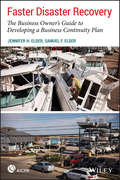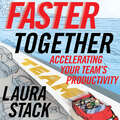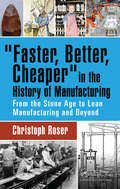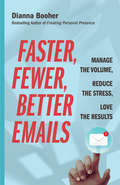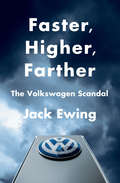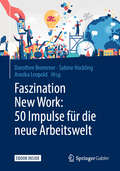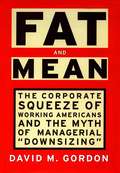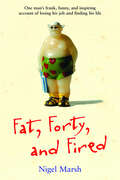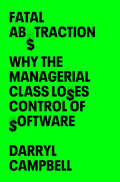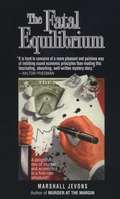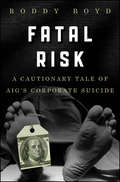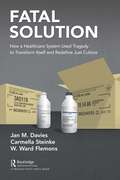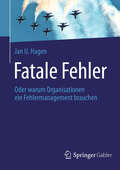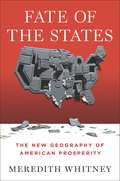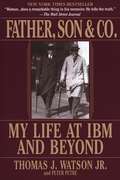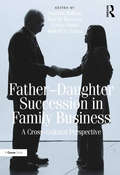- Table View
- List View
Faster Cheaper Better: The 9 Levers for Transforming How Work Gets Done
by Michael Hammer Lisa HershmanA bold and revolutionary thinker's legacy for how business can meet the greatest economic challenge in decades... It's no secret: everyone knows that the way most companies do things is screwed up. Surprisingly, though, herein lays the biggest opportunity for improving growth and profitability in a world in which consumers are tapped out and competition is coming from the devastating combination of low-wage countries with high skills. For more than a decade, following his landmark Reengineering the Corporation, Michael Hammer did "deep dives" into the processes of companies in every imaginable business--from oil refineries to software developers, factories, retailers, and hospitals--to understand the nuts and bolts of how they do their work, and then to advise them how to do it differently to become faster, cheaper, better. The results were the right product, at the right time, with the right price and quality--businesses that not only ate the competitions' lunch but their breakfast and dinner, too. The research and passion Dr. Hammer brought to this book have been ably carried on, following his tragic and unexpected death in 2008, by his colleague, Lisa Hershman, now the CEO of Hammer and Company. Looking at a company's operations not in terms of piecemeal fragments of work performed in a slew of isolated functional departments but as large-scale holistic work units transformed many companies, enabling them to meet the unique challenges of our time. The late DR. MICHAEL HAMMER was the coauthor of Reengineering the Corporation and the author of The Agenda. LISA W. HERSHMAN is the CEO of Hammer and Company.From the Hardcover edition.
Faster Disaster Recovery: The Business Owner's Guide to Developing a Business Continuity Plan (AICPA)
by Jennifer H. Elder Samuel F. ElderProtect your company’s finances in the event of a disaster In the face of an environmental or man-made disaster, it’s imperative to have a contingency plan that’s mapped out your corporation’s strategy to minimize the impact on the daily functions or life of the corporation. Successful planning not only can limit the damage of an unforeseen disaster but also can minimize daily mishaps—such as the mistaken deletion of files—and increase a business's overall efficiency. Faster Disaster Recovery provides a 10-step approach for business owners on creating a disaster recovery plan (from both natural and man-made events). Each chapter ends with thought-provoking questions that allow business owners to explore their particular situation. Covers natural events such as earthquakes and floods Provides guidance on dealing with man-made events such as terrorist attacks Offers worksheets to make your contingency plans Includes several examples throughout the book There’s no time like the present to develop a business contingency plan—and this book shows you how.
Faster Smarter Microsoft® Office System -- 2003 Edition
by Katherine MurrayNow you can do the things you do every day with Office--create reports, manage finances, send e-mail, and make a presentation--but do them faster, smarter, and better. Dive in! This friendly, focused guide shows the best ways to use the core features in your Office programs, so you spend more time doing and less time learning. Use the quick lists, numbered steps, and helpful examples to accelerate your productivity--and do the cool things you want to do! Discover how to: Get your e-mail, calendar, and work day under control Create professional-looking documents--from memos and invoices to complex reports Use spreadsheets and charts to analyze data and support decision making Produce and deliver a compelling presentation with great visuals and special effects Communicate and work together more effectively using enhanced collaboration features Quickly build a dynamic Web site with data-driven features Use XML to make your data go farther Share and reuse information among programs to simplify work and get better resultsLearn about Office the Faster Smarter way! 10-Second Summary--see what each chapter covers at a glance Fast Wrap-Up--review key points and takeaways from every chapter Real-World Examples--apply what you learn to real work, right now Aha! Tips--get insider tips and insights to fuel your productivity Top 10 Troubleshooting Solutions--find fast answers, right inside the cover!
Faster Together: Accelerating Your Team's Productivity
by Laura StackFaster TogetherAccelerating Your Team's Productivity There are more roadblocks to productivity today than ever before. Everyone who works must deal with countless emails, constant communication, cascading deadlines, and seemingly endless meetings. These can be managed efficiently, or they can be a huge time suck. When you're surrounded by slow-moving coworkers, you're stuck in a traffic jam of sorts. What makes the difference isn't individuals working harder or faster or smarter but “teaming well.” You have at your disposal what Stack calls “the most powerful productivity machine in existence”: your team. Individual productivity is just the beginning of business profitability; the real winner is team productivity. A good team can accomplish more, and more quickly, than any one Lone Ranger. Yes, there are always stars—in sports, Peyton Manning, Mia Hamm, and Stephen Curry come to mind—but they couldn't do their jobs without the rest of the team doing theirs. Bestselling author Laura Stack's FAST model mobilizes teams to be the most effective they can be, while keeping each other's best interests at heart. Using her original model, teams learn to work together Fairly, accept Accountability, apply Systems Thinking, and maximize available Technology. An interactive assessment helps you evaluate your team's current speed and rate of acceleration. By the end of this book, you'll truly understand the abilities of your team. Team members will ask themselves, “How can I help my team go faster together?” You work to save everyone else time, and they work to save you time. For your business to win, everyone must contribute. As Stack puts it, “Team up; don't slow down!”So, rev your team's engines, and you'll soon be roaring down the track together!
Faster, Better, Cheaper in the History of Manufacturing: From the Stone Age to Lean Manufacturing and Beyond
by Christoph RoserThe industrial revolution, mechanization, water and steam power, computers, and automation have given an enormous boost to manufacturing productivity. "Faster, Better, Cheaper" in the History of Manufacturing shows how the ability to make products faster, better, and cheaper has evolved from the stone age to modern times. It explains how different developments over time have raised efficiency and allowed the production of more and better products with less effort and materials, and hence faster, better, and cheaper. In addition, it describes the stories of inventors, entrepreneurs, and industrialists and looks at the intersection between technology, society, machines, materials, management, and – most of all – humans. "Faster, Better, Cheaper" in the History of Manufacturing follows this development throughout the ages. This book covers not only the technical aspects (mechanization, power sources, new materials, interchangeable parts, electricity, automation), but organizational innovations (division of labor, Fordism, Talyorism, Lean). Most of all, it is a story of the people that invented, manufactured, and marketed the products. The book shows how different developments over time raised efficiency and allowed production of more with less effort and materials, which brought us a large part of the wealth and prosperity we enjoy today. The stories of real inventors and industrialists are told, which includes not only their successes but also their problems and failures. The effect of good or bad management on manufacturing is a recurring theme in many chapters, as is the fight for intellectual property through thrilling tales of espionage. This is a story of successes and failures. It is not only about technology but also about social aspects. Ultimately, it is not a book about machines but about people!
Faster, Fewer, Better Emails: Manage the Volume, Reduce the Stress, Love the Results
by Dianna BooherBusiness communication expert and bestselling author Dianna Booher shares practical wisdom on how to write effective emails that get results and how to organize documents to gain control and increase your productivity.Today, most business writing is email writing. We handle even our most important customer transactions, internal operations, and supplier partnerships solely by email. Yet many of us still struggle to write emails that get results. And we often are so overwhelmed by the sheer volume of emails that we feel as though we're in email jail! How we handle email has a large impact on the trajectory of our career. Emails can build or destroy credibility, clarify or confuse situations for our coworkers and customers, and reduce or increase security risks and legal liabilities. This book will help you master your emails and stand out as a clear, credible communicator. After all, clear, credible communicators become leaders in every industry. With more than three decades of experience analyzing emails across various industries for corporate clients, Booher offers guidance on how to identify and stop email clutter so you can increase productivity while improving communication flow. In this book, you will learn how to:• Compose actionable emails quickly by following Booher's philosophy of Think First, Draft Fast, and Edit Last • Write concise emails that get read so you get a quick response• Organize a commonsense file storage system that helps you find documents and emails quickly to attach and send• Present a professional image when you email prospects, customers, and coworkers• Be aware of legal liabilities and security risks as you send and receive email
Faster, Higher, Farther: The Volkswagen Scandal
by Jack Ewing“A rich history of a company whose cars, for better and worse, have touched millions of lives, a character study of a brilliant but deeply flawed leader, and a case study in how a corporate culture can turn toxic.” —Bethany McLean, New York Times Book Review Faster, Higher, Farther chronicles a corporate scandal that rivals those at Enron and Lehman Brothers—one that will cost Volkswagen more than $22 billion in fines and settlements. Through meticulous reporting, New York Times correspondent Jack Ewing documents why VW felt compelled to install “defeat devices” in diesel vehicles that unlawfully lowered CO2 levels during emissions testing, and how the fraud was committed, covered up, and finally detected. Faster, Higher, Farther is a briskly written account of unrivaled corporate greed. Updated with the latest information and a new afterword by the author.
Faszination New Work: 50 Impulse für die neue Arbeitswelt
by Dorothee Brommer Sabine Hockling Annika LeopoldMit diesem Buch hält das Konzept der New Work auch in Ihrem Unternehmen EinzugIn diesem Praxisbuch erfahren Sie fundiert und praxisnah, was die verschiedenen Schwerpunkte von New Work sind und welche Potenziale dieses Konzept in der realen Arbeitswelt entfalten kann. Die Autoren geben Impulse, wie z.B. innovatives Recruiting und Personalmarketing angesichts des rasanten Wandels im Bereich Human Ressource (HR) aussehen kann. Das Buch ist im Schnellverfahren, in einem Book Sprint, entstanden. Dafür haben die Herausgeberinnen innerhalb eines Wochenendes fundierte Beiträge von Experten der Bereiche Digitalisierung, Beratung und Führung zusammengetragen – geballtes Fachwissen für die erfolgreiche Transformation zur New-Work-Kultur. Daraus entstanden ist eine abwechslungsreiche und interessante Mischung inklusive:• 20 Autoren-Beiträgen• 16 Experten-Kurzinterviews• 13 Impulse in Zitatform von bekannten Neu-DenkernAuf diese Weise werden in diesem Buch inhaltlich verschiedene Themen behandelt: • Lernen in der Organisation• Menschen in der neuen Arbeitswelt• Agile Feedbacksysteme von morgen• Agiles Leadership• New-Work-Spaces• Gesundheitskultur von morgen• Nutzerzentriertes Personalmarketing• Kunst als neue Form im Unternehmen• Vergütung von morgenLassen Sie sich von neuen Denkansätzen und Empfehlungen inspirierenDoch dieses New-Work-Buch spiegelt nicht nur die Erfahrungen verschiedener Impulsgeber wider. Es liefert außerdem konkrete Handlungsempfehlungen, beleuchtet die Daseinsberechtigung von bisherigen Prozessen sowie Strukturen und vernetzt diese mit den Ansprüchen der neuen Arbeitswelt. Zudem behandeln die Autoren neue Denkansätze zur Rolle von HR, um New Work gewinnbringend in der Unternehmenskultur zu verankern – eine Anleitung zum Nachahmen für Praktiker und Experten mit vielen anschaulichen, farbigen Illustrationen.
Faszination Psychologie – Berufsfelder und Karrierewege
by Simon Werther Maximilian MendiusDieser Ratgeber nimmt Sie mit auf eine faszinierende Reise durch die vielfältigen Tätigkeitsfelder von Psychologinnen und Psychologen. Dabei lernen Sie neben den etablierten Anwendungsgebieten wie klinische Psychologie und Wirtschaftspsychologie auch vermeintlich exotische Arbeitsfelder wie Polizei- oder Verkehrspsychologie kennen. Finden Sie für sich heraus, ob Ihr Herz für eine Tätigkeit in der Psychologie schlägt und wie Sie diesen Wunsch verwirklichen können. Alle Kapitel sind von Experten aus der Praxis verfasst. Sie vermitteln Ihnen sowohl einen authentischen als auch realistischen Einblick in den jeweiligen Berufsalltag und räumen auf mit gängigen Vorurteilen. Darüber hinaus verleihen eingeflochtene Interviews mit praktisch tätigen Psychologen und Experten aus der Wissenschaft bereichernde Perspektiven. Wir bieten Ihnen:über 25 Autoren mit langjähriger Praxiserfahrungüber 15 zusätzliche Experteninterviews mit erfahrenen Praktikernüber 15 Meinungen von Professoren und anderen wissenschaftlichen Experten In dieser zweiten Auflage finden Sie neben einer Aktualisierung auch eine Erweiterung um interkulturelle Tätigkeiten in der Psychologie, um Schulpsychologie sowie um rechtliche Aspekte und Schweigepflicht.Dieses Buch ist nicht nur ideal für Bachelor-, Master- und Nebenfachstudierende der Psychologie, sondern für alle, die sich für Psychologie interessieren. Kommen Sie an Bord und lassen auch Sie sich von der Psychologie faszinieren!
Faszination Psychologie – Berufsfelder und Karrierewege
by Maximilian Mendius and Simon WertherDie Bedeutung der Psychologie in unserer Gesellschaft hat in den letzten Jahrzehnten zugenommen. Dies spiegelt sich auch in den steigenden Studentenzahlen im Bereich der Psychologie wider, sowie darin, dass ständig neue Tätigkeitsfelder für Psychologen erschlossen werden. Daher ist es für Psychologiestudierende oft unklar, welche Berufsbilder es in der Psychologie überhaupt gibt. Da Psychologiestudierende schon frühzeitig Studienschwerpunkte wählen müssen, fühlen sie sich überfordert, die richtige Entscheidung zu treffen. Sie fragen sich beispielweise, ob eine klinische oder wirtschaftspsychologische Ausbildung für sie sinnvoller ist. So sehnen sie sich nach Informationen, die ihnen diese Entscheidung erleichtert. Auch besteht oft die Frage, welche Inhalte aus dem Studium wirklich für die spätere praktische Arbeit relevant sind und wie sie als Psychologieabsolvent erfolgreich auf dem Arbeitsmarkt bestehen können.Diesen Bedarf nach Literatur und Wegweisung zur Berufsfindung und Orientierung greift dieses Werk auf und bietet genau dies: Es nimmt den Leser mit auf eine Reise durch die vielfältigen Tätigkeitsfelder von Psychologinnen und Psychologen. Dabei lernt der Leser nicht nur die etablierten Anwendungsgebiete wie klinische Psychologie und Wirtschaftspsychologie kennen, sondern auch vermeintlich eher exotische Arbeitsfelder. Somit bietet es einen hilfreichen Gesamtüberblick über die vielfältigen Karrieremöglichkeiten für alle mit psychologischen Studienabschlüssen. Die Herausgeber sind die Gründer des Psychologiestudentenkongresses, der einmal jährlich zu diesem Thema in München stattfindet. Die einzelnen Kapitel sind durchwegs von Experten aus der Praxis mit umfangreichem Erfahrungsschatz verfasst. Sie vermitteln einen authentischen wie auch einen realistischen Einblick in den Berufsalltag des jeweiligen Tätigkeitsbereichs. Darüber hinaus verleihen eingeflochtene Interviews mit praktisch tätigen Psychologen und Experten aus der Wissenschaft den Kapiteln bereichernde Perspektiven. Damit wendet sich dieses Buch nicht nur an Bachelor- und Masterstudierende der Psychologie, sondern genauso an Nebenfachstudierende sowie an alle, die sich für Psychologie interessieren.
Fat and Mean: The Corporate Squeeze of Working Americans and the Myth of Managerial Downsizing
by David M. GordonSince the early 1980s, economic experts have recommended "downsizing" as the best way for U.S. corporations to remain competitive. Reducing unnecessary staff would lower costs, increase profits, and transform these companies into lean, mean production machines. As many American businesses pursued this strategy-often in the wake of mergers and acquisitions that left them with an unwieldy layer of middle management-and raised their bottom line, it seemed the experts were right. Yet as David M. Gordon shows in this iconoclastic book, most of them have really only gone halfway. They are "mean," but far from lean. Tracing the overall employment patterns of the past decade, Gordon shows that most American companies actually employ more managers and supervisors than ever before. These ever-increasing functionaries control company payrolls and pay themselves generous salaries-at the expense of average workers. For despite a steadily growing economy the real wages of the American worker have been falling for the past 20 years. To explain this decline and the much-debated "wage gap" that resulted, pundits and professors invoke various causes ranging from the flow of production jobs overseas to the average worker's lack of the technological skills needed in today's "knowledge economy." But Gordon exposes the single greatest factor in this decline, a corporate strategy that penalizes line workers and hinders businesses from competing effectively in world markets: the simultaneous overstaffing of management hierarchies and the inadequate compensation of workers. Instead of sharing profits with their employees, thus encouraging them to work harder, management has more often opted to prod workers by instilling fear of layoffs. Gordon unerringly plots the shortsighted and disastrous course of U.S. corporations, and documents the tremendous social and personal costs to their employees. Yet in addition to telling the harsh truth about downsizing, he suggests policies to ensure fairer business practices. Wages can increase- indeed, they must-as the economy begins to perform more efficiency. U.S. corporations have become fat and mean. They need to become lean and decent-not just for the sake of their workers, but for the sake of their competitive advantage. This provocative and original book shows how they can.
Fat, Forty, and Fired: One Man's Frank, Funny, and Inspiring Account of Losing His Job and Finding His Life
by Nigel MarshA &“touching and laugh-out-loud funny&” memoir about a suddenly unemployed CEO, his family, and the things he discovered when his job disappeared (Booklist). As a stressed husband and father of four small children under the age of eight, Nigel Marsh was enslaved to his mortgage, recuperating from an embarrassing surgery, and suddenly fired from his corporate career. Deciding to venture off the treadmill in search of a more meaningful and balanced existence, Marsh tackled the art of hands-on parenting while simultaneously training for an ocean swimming race and coming to terms with his alcoholism. Touching on topics ranging from marital sex (or lack thereof), dieting, and parenthood to work, love, football, religion, self-help books, and sharks, this &“hilarious and inspiring&” international bestseller is &“Homer Simpson meets Anthony Robbins . . . essential reading for anyone whose life has ever hit a roadblock&” (Bob Rosner, bestselling author of Working Wounded)æ&” &“Both witty and helpful . . . If there is any flaw to this book, it is that Marsh repeatedly makes the reader laugh out loud and want to read paragraphs at length to any nearby willing listener.&” —Shelf Awareness &“Marsh&’s epiphanies during his hiatus include the realization that he is fat, but more poignantly, that he is an alcoholic . . . The strength of the memoir lies in the intimate and often humorous moments he shares as he reconnects with his wife and four children.&” —Publishers Weekly &“An extremely funny and touching account of how someone can use humor and optimism to put adversity into perspective . . . a thoroughly enjoyable read.&” —Paul Wilson, author of The Little Book of Calm
Fatal Abstraction: Why the Managerial Class Loses Control of Software
by Darryl CampbellA tech insider explains how capitalism and software development make for such a dangerous mix. Software was supposed to radically improve society. Outdated mechanical systems would be easily replaced; programs like PowerPoint would make information flow more freely; social media platforms like Facebook would bring people together; and generative AI would solve the world’s greatest ills. Yet in practice, few of the systems we looked to with such high hopes have lived up to their fundamental mandate. In fact, in too many cases they’ve made things worse, exposing us to immense risk at the societal and the individual levels. How did we get to this point? In Fatal Abstraction, Darryl Campbell shows that the problem is “managerial software”: programs created and overseen not by engineers but by professional managers with only the most superficial knowledge of technology itself. The managerial ethos dominates the modern tech industry, from its globe-spanning giants all the way down to its trendy startups. It demands that corporate leaders should be specialists in business rather than experts in their company’s field; that they manage their companies exclusively through the abstractions of finance; and that profit margins must take priority over developing a quality product that is safe for the consumer and beneficial for society. These corporations rush the development process and package cheap, unproven, potentially dangerous software inside sleek and shiny new devices. As Campbell demonstrates, the problem with software is distinct from that of other consumer products, because of how quickly it can scale to the dimensions of the world itself, and because its inner workings resist the efforts of many professional managers to understand it with their limited technical background. A former tech worker himself, Campbell shows how managerial software fails, and when it does what sorts of disastrous consequences ensue, from the Boeing 737 MAX crashes to a deadly self-driving car to PowerPoint propaganda, and beyond. Yet just because the tech industry is currently breaking its core promise does not mean the industry cannot change, or that the risks posed by managerial software should necessarily persist into the future. Campbell argues that the solution is tech workers with actual expertise establishing industry-wide principles of ethics and safety that corporations would be forced to follow. Fatal Abstraction is a stirring rebuke of the tech industry’s current managerial excesses, and also a hopeful glimpse of what a world shaped by good software can offer.
Fatal Equilibrium
by Marshall JevonsDennis Gossen is dead, an apparent suicide, after his career in economics has been cut short by the Harvard Promotion and Tenure Committee. When two members of that committee are killed, Gossen's fiancé e, Melissa Shannon, finds herself indicted for murder. Once again, Henry Spearman, Professor of Economics at Harvard, finds himself on the track of a murderer and once again Marshall Jevons presents his readers with a captivating murder mystery riddle. <p><p> Was it Morrison Bell, mathematics star, inventor of devices to defeat the squirrels in his birdfeeders? Or was it owl-like Oliver Wu, the distinguished sociologist who harbors deep resentments? Was it Valerie Danzig, supposedly former "item" with Dennis Gossen? Or maybe Foster Barrett, gourmet Harvard classicist? What about Christolph Burckhardt, infatuated employer of Gossen's fiancé e? Or Sophia Ustinov, Russian emigré , lover of American poetry and Borzoi hounds? Three lives come to an end. And when Spearman begins to piece it together, the murderer and Henry find themselves face to face on a luxury liner in a storm at sea in the fourth and final Fatal Equilibrium. <p> For the reader who follows the clues, the solution to this conundrum is, as usual in the best of this genre, elementary. The difference in this case is that it is elementary economics. "The Fatal Equilibrium" is a mystery novel that provides a grasp of basic economics on the way to finding out whodunit. Its predecessor, "Murder at the Margin," has already achieved a cult following. In a review of Jevon's earlier book, "The Wall Street Journal" remarked that "if there is a more painless way to learn economicprinciples, scientists must have recently discovered how to implant them in ice cream."
Fatal Risk: A Cautionary Tale of AIG's Corporate Suicide
by Roddy BoydLong-listed for the FT & Goldman Sachs Business Book of the Year Award 2011 The true story of how risk destroys, as told through the ongoing saga of AIG From the collapse of Bear Stearns and Lehman Brothers, the subject of the financial crisis has been well covered. However, the story central to the crisis-that of AIG-has until now remained largely untold. Fatal Risk: A Cautionary Tale of AIG's Corporate Suicide tells the inside story of what really went on inside AIG that caused it to choke on risk and nearly brining down the entire economic system. The book Reveals inside information available nowhere else, including the personal notes and records of key players such as the former Chairman of AIG, Hank Greenberg Takes readers behind the scenes at the U.S. Treasury and the Federal Reserve Bank of New York Details how an understanding of risk built AIG, but a disdain for government regulators led to a run-in with New York State Attorney General Eliot Spitzer Fatal Risk is the comprehensive and compelling true story of the company at the center of the financial storm and how it nearly caused the entire economic system to collapse.
Fatal Solution: How a Healthcare System Used Tragedy to Transform Itself and Redefine Just Culture
by Jan M. Davies, MSc, MD, FRCPC, FRAeS Carmella Steinke, RRT, BHS(RT), MPA W. Ward Flemons, MD, FRCPCOne box of chemicals mistaken for another. Ingredients intended to be life-sustaining are instead life-taking. Families in shock, healthcare providers reeling and fingers starting to point. A large healthcare system’s reputation hangs in the balance while decisions need to be made, quickly. More questions than answers. People have to be held accountable – does this mean they get fired? Should the media and therefore the public be informed? What are family members and the providers involved feeling? When the dust settles, will remaining patients be more safe or less safe? In this provocative true story of tragedy, the authors recount the journey travelled and what was learned by, at the time, Canada’s largest fully integrated health region. They weave this story together with the theory about why things fall apart and how to put them back together again. Building on the writings and wisdom of James Reason and other experts, the book explores new ways of thinking about Just Culture, and what this would mean for patients and family members, in addition to healthcare providers. With afterwords by two of the major players in this story, the authors make a compelling case that Just Culture is as much about fairness and healing as it is about supporting a safety culture.
Fatale Fehler
by Jan U. HagenIch irre, also bin ich, schrieb Augustinus, und Benjamin Franklin war der Meinung, die Geschichte der menschlichen Irrtümer sei interessanter als diejenige ihrer Erfindungen; doch wenn wir uns irren und Fehler machen, ärgern wir uns und fühlen uns peinlich berührt. Am unangenehmsten sind uns die Fehler, die uns geschäftlich unterlaufen, denn auf dieser Ebene ist das Publikum in der Regel größer als im privaten Kreis. Dass diese Einstellung verhängnisvoll ist, demonstriert Jan Hagen auf faszinierende Weise anhand einschlägiger Beispiele aus der zivilen und militärischen Luftfahrt. Ebenso eindrucksvoll beschreibt er, wie dort nach und nach ein einschlägiges Fehlermanagement entwickelt wurde, die Widerstände, die auf dem Weg dahin überwunden werden mussten, und die langsame aber letztlich erfolgreiche Generierung jener sachlichen, fehlerdiagnostischen Kultur, die heute jedes moderne Unternehmen braucht.
Fatale Fehler
by Jan U. HagenIch irre, also bin ich, schrieb Augustinus, und Benjamin Franklin war der Meinung, die Geschichte der menschlichen Irrt#65533;mer sei interessanter als diejenige ihrer Erfindungen; doch wenn wir uns irren und Fehler machen, #65533;rgern wir uns und f#65533;hlen uns peinlich ber#65533;hrt. Am unangenehmsten sind uns die Fehler, die uns gesch#65533;ftlich unterlaufen, denn auf dieser Ebene ist das Publikum in der Regel gr#65533;#65533;er als im privaten Kreis. Dass diese Einstellung verh#65533;ngnisvoll ist, demonstriert Jan Hagen auf faszinierende Weise anhand einschl#65533;giger Beispiele aus der zivilen und milit#65533;rischen Luftfahrt. Ebenso eindrucksvoll beschreibt er, wie dort nach und nach ein einschl#65533;giges Fehlermanagement entwickelt wurde, die Widerst#65533;nde, die auf dem Weg dahin #65533;berwunden werden mussten, und die langsame aber letztlich erfolgreiche Generierung jener sachlichen, fehlerdiagnostischen Kultur, die heute jedes moderne Unternehmen braucht.
Fatalism and Development: Nepal's Struggle for Modernization
by Dor Bahadur BistaDor Bahadur Bista, being a Nepali, recounts all the events of the country's struggle to modernize from being a monarchy.
Fate of the States
by Meredith Whitney"Forget everything you think you know about the direction of the American economy, about our growing need for foreign oil, about the rise of the service economy and the decline of American manufacturing. The story of the next thirty years will not be a repeat of the last thirty." One of the most respected voices on Wall Street, Meredith Whitney shot to global prominence in 2007 when her warnings of a looming crisis in the financial sector proved all too prescient. Now, in her first book, she expands upon her biggest call since the financial crisis. Whitney points out that it wasn't just consumers who binged on debt for the past twenty years but state and local governments too. She explains how the fiscal sins of the past are beginning to transform the U.S. economy along regional lines. And she shows how we are moving into a new era in which wealth, power, and opportunity flow away from the coasts and toward the central corridor. The housing boom was initially great for states such as California, Nevada, and Florida. State and municipal coffers overflowed, unemployment shrank, and local governments spent their tax-revenue windfalls on pay hikes and pension increases for their public employees. But when the boom dried up in those parts of the country, so too did the tax revenues, forcing tax-rate hikes and cuts to essential public services--especially education and infrastructure. In contrast to those doom and gloom headlines, a much different trend was developing in interior states such as North Dakota, Indiana, and Texas. They survived the housing crisis relatively unscathed, avoiding mass foreclosures and budgetary chaos. As a result they've had the money to retrain workers and offer tax incentives to companies willing to relocate. Coupled with the recent booms in natural gas and oil extraction and a resurgence in manufacturing, these states are poised to become the new powerhouses of the American economy. Whitney offers a sobering vision of the next few decades, with the coastal states continuing to struggle while the central corridor continues to thrive. She explores the consequences of roughly half the country stuck in a vicious cycle of decline while the other half enjoys a virtuous circle of growth. Whitney also offers practical ideas to help the struggling parts of the country--before the fate of the states becomes irreversible.
Fate of the Vasa
by Richard Mason Alan MaccormackIn 1628, the royal warship Vasa was launched. It was Sweden's most expensive naval vessel ever built, costing over 5% of GNP. On its maiden voyage, the ship sailed 1,400 yards in its own harbor, heeled over to the side, and then sank. One third of the 150 crew and officers were killed. An inquiry was convened to establish the cause of the disaster, with testimony taken from, among others, the ship's captain, its officers, the ship's designer, and those responsible for its construction. No one was found guilty of negligence. The question is "Why did the Vasa sink?" The answer lies in the state of knowledge about shipbuilding of the time, the continual changes requested by the king, who was fighting in the Baltic, and the resulting experimental nature of the design.
Father's Love: Novazyme Pharmaceuticals, Inc.
by Bradley Campbell Richard BohmerJohn Crowley, CEO of Novazyme Pharmaceuticals, a start-up biotechnology firm developing an orphan drug to treat a rare lysosomal storage disorder from which his children suffer, must choose between a partnership and a buyout to have sufficient funds and support to get the drug to the market. Accompanying this dilemma are questions relating to Novazyme's clinical trial strategy, marketing, sales, production, and pricing. This case introduces students to the FDA drug approval process and government-supported financial inducements to develop drugs for small patient populations. Also provides insight into the nature of strategic relationships in the biotechnology and pharmaceutical industries.
Father, Son & Co.: My Life at IBM and Beyond
by Peter Petre Thomas J. WatsonIn this eloquent first-person account of a family drama that changed the face of American business, the man who transformed IBM into the world's largest computer company reflects on his lifelong partnership with his father--and how their management style and shared dedication to excellence united to create a unique corporate culture that became the blueprint for the entire technology boom.In the course of sixty years Thomas J. Watson Sr. and his son, Thomas J. Watson Jr., together built the international colossus that is IBM. This is their story: a riveting and revealing account of two men who loved each other--and fought each other--with a terrible fierceness.But along with the story of a father and son, this is IBM's story too. It chronicles the management insights that shaped its course and its unique corporate culture, the style that made Thomas Watson Sr. one of America's most charismatic bosses, and the daring decisions by Thomas Watson Jr. that transformed IBM into the world's largest computing company. One of the greatest business-success stories of all time, Father, Son & Co. is a moving lesson for fathers who dream for their children, as well as a testament to American ingenuity and values, told in a disarmingly frank and eloquent voice.Promising to remain an important business reference as we move into the next century, FATHER, SON & CO. takes a look at the management insight that helped to shape IBM's course and unique corporate culture. It looks at Watson, Sr., one of America's most charismatic bosses, and Watson, Jr., who spurred IBM into the computer age.Ten years after its original publication, FATHER, SON & CO. remains a uniquely honest book. Watson's willingness to write about the loving but ferociously combative relationship he had with his father and the turbulent battles behind some of IBM's most far-reaching decisions gives readers rare insights into the realities of leadership. -->
Father, Son, and Company: My Life at IBM and Beyond
by Thomas J. Watson Jr. Peter PetreAlong with the story of a father and son, this is IBM's story too. It chronicles the management insights that shaped its course and its unique corporate culture, the style that made Thomas Watson Sr. one of America's most charismatic bosses, and the daring decisions by Thomas Watson Jr. that transformed IBM into the world's largest computing company. One of the greatest business-success stories of all time, "Father, Son & Co." is a moving lesson for fathers who dream for their children, as well as a testament to American ingenuity and values, told in a disarmingly frank and eloquent voice.
Father-Daughter Succession in Family Business: A Cross-Cultural Perspective
by Paul W. Thurman Robert S. NasonTo whom does a father, retiring from his life as a successful entrepreneur, pass control of the business he has built? Once it would always have been his eldest son, but increasingly women are becoming involved in family firms having risen to positions of influence and leadership. Using revealing case studies from the daughters who succeeded their entrepreneur fathers in a wide variety of challenging situations, cultures and continents, Father-Daughter Succession in Family Business discusses the changes which have led to daughters gaining influence in more and more family businesses. It looks at the tensions this succession can produce between old notions of how men and women should behave, and the new style of leadership that often comes about when a woman takes the helm. This book will help consultants, business educators, and researchers, as well as those who are themselves involved in significant family managed enterprises to better understand why it can no longer be assumed in any part of the World that the first born son will take over the reins of the family business.

